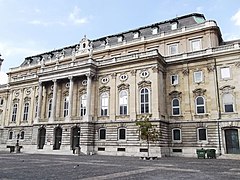Porto Pellegrini
Port of Pellegrini
Porto Pellegrini | |
|---|---|
Capital City | |
From top, left to right, Skyline of Almeiveira, March 11 Obelisk, Adamantine Capitol Building, and the Liberator Complex | |
| Nicknames: | |
 Location of Porto Pellegrini (red) in both the Federal District (outlined) and Adamantina | |
| Country | Adamantina |
| State | Federal District of Pellegrini |
| Established | June 11 1862 |
| Founded by | National Congress of Adamantina |
| Seat | City-Provincial Building |
| Government | |
| • Body | Porto Pellegrini City Council |
| • Mayor | Casimiro Lucciano (S) |
| Area | |
| • Total | 325 km2 (125 sq mi) |
| Elevation | 82 m (269 ft) |
| Population (2022) | |
| • Total | 3,548,094 |
| • Rank | 1st |
| • Density | 10,917/km2 (28,270/sq mi) |
| Demonym | Pellegrino |
| Time zone | UTC-9 (Western Lumine Time) |
| Area code(s) | 181, 182 and 183 |
| Major airports | |
| Commuter rail | Metropolitana Rail |
| Rapid transit | Porto Pellegrini Transit Authority |
Porto Pellegrini officially the City of Porto Pellegrini (Vespasian: Comune di Porto Pellegrini), also known as Pellegrini, is the capital city of the Adamantine Republic. With a 2020 population of 3,348,094 distributed over 325 square kilometers (125 sq mi), Porto Pellegrini is the most densely populated major city in Adamantina. Located on the west bank of the Pellegrini River, which forms the border between the Federal District of Pellegrini and the province of Prosperita, the city is the center of the Porto Pellegrini metropolitian area, the largest metropolitan area in the country. With over 9.4 million people in its unified statistical area, Porto Pellegrini is the urban anchor for approximately thirty percent of the nation's total population. Porto Pellegrini has been described as the political, cultural, financial and media capital of Adamantina. Colloquial nicknames for Porto Pellegrini include P Two, The Slaughterhouse, Po Pell, and Verlois of the South.
Established as a planned city in 1843, it was named Pellegrini, a Vespasian word for "foreigner" as the city was meant to be the entry point and primary settlement for immigrants entering the nation during the era of mass immigration. The former settlements of Almeiveira, Camporaele and Paremunde were razed and reestablished as neighborhoods within the planned city. The government relocated the capital to Porto Pellegrini from Sarro City in 1862. By 1870 the population had grown significantly, and the expansion of immigration population led to a series of nativist riots that caused the Great Porto Pellegrini Fire, destroying several square miles and left more than 150,000 homeless. During reconstruction of the city, the local government enacted the nation's first segregation ordinances. Porto Pellegrini made noted contributions to urban planning and zoning standards not seen elsewhere in Asteria Inferior throughout the late 19th and early 20th centuries. In 1944 the city was among the first to desegregate within Adamantina, leading to a third wave of mass immigration from 1946 to 1957. Approximately six hundred languages are spoken in Porto Pellegrini, making it one of the most linguistically diverse cities in the world.
Porto Pellegrini is the center of the nations meat packing industry, processing and packaging nearly 80% of all exported cattle, pigs and poultry originating from Adamantine farms. It is the site of the nation's stock market and derivatives market; the Porto Pellegrini Stock Exchange (PPST) and the Porto Pellegrini Board of Trade (PPBT). Its metropolitan area has the largest number of federal highways, and the highest density of railroad track in the nation. It is connected to international trade through its seaport; the Port of Pellegrini and Prosperita. Antonio Malito International Airport, is the nation's busiest airport. As of 2020, the Porto Pellegrini metropolitan area is estimated to produce a gross metropolitian product (GMP) of approximately $150 billion, roughly one third of Adamantina's entire gross national product.
Porto Pellegrini is divided into 805 wards, 53 council districts (6 at-large districts), and 24 neighbourhoods. Utilizing a strong-mayoral government, the Mayor of Porto Pelligrini is one of the most politically influential positions within the country, on par with many of the provincial governors. Roughly seventeen congressional districts reside within the city's border, the same amount as the second largest province; San Loreto. The regional offices of the Community of Nations (CN), Organization of Asterian Nations (OAN), Asteria Inferior Common Market (AICM) and the International Trade Organization (ITO) are located within the city's downtown.
Etymology
History
Geography
Climate
Porto Pellegrini has a oceanic climate (Köppen: Cfb), influenced by a cold ocean current from the Haillet Sea, with mean temperatures of 10 °C (50 °F) during the winter and a mean temperature of 25 °C (77 °F) during the summer. The overall climate throughout the year is mild and moderately wet. Each year, however, there are a few days when the temperature rises above 32 °C (90 °F). Longer periods of more intense heat sometimes occur, such as the heat wave of 2017 when temperatures exceeded 30 °C (86 °F) for weeks, reached 40 °C (104 °F) on some days and rarely cooled down at night. Spring and autumn have, on average, mild days and fresh nights but are changing and unstable. Surprisingly warm or cool weather occurs frequently in both seasons. In winter, sunshine is scarce; days are cool, and nights are cold but generally above freezing with low temperatures around 3 °C (37 °F).
Porto Pellegrini has an average annual precipitation of 641 mm (25.2 in), and experiences light rainfall distributed evenly throughout the year. However, the city is known for intermittent, abrupt, heavy showers and thunderstorms.
Demographics
Economy
Education
Culture

Porto Pellegrini is strongly influenced by Euclean culture, and is sometimes referred to as the "Verlois of the South". It is the center of the Adamantine culture, and has a strong connection to live performative arts. Roughly 200 active theaters host plays every weekend, with the Porto Pellegrini Palladium being the most prestigious musical theatre in the country. Some culturally influential plays created by Porto Pellegrini based playwriters included Rieti, Rieti! (1942), Hayseed of San Loreto (1952), Al dente Macellaio (1963), La Lotta (1967) and Malito e le Ombre (1995).
Government and politics
| City Hall of Porto Pellegrini |
|---|
|
Government (58) * Solidarista (58) Opposition (2) * Independent (2) |
City Hall of Porto Pellegrini contains both the municipal legislative chamber and mayoral offices.]]The government of the City of Porto Pellegrini is divided into two branches; the executive and and legislature. The Mayor of Porto Pellegrini is the chief executive, elected by general election for a term of four years, with no term limits. The current mayor is Casimiro Lucciano. The mayor appoints commissioners and other officials who oversee the various city departments, including the Chief of Police, the Fire Chief and the Chief Engineer of Public Works. The Mayor also has the ability to veto legislation. The Porto Pellegrini City Council is the legislative branch of the city and is comprised of 53 council districts and 6 at-large districts. These districts are known as wards (reparti), and the council members are known as aldermen (assessori).
The Porto Pellegrini Police Department provides protective services and law enforcement and the Porto Pellegrini Fire Department provides fire suppression and emergency health services for city residents. Civil and criminal law cases are heard in the Federal District Circuit Court of the Federal District court system. The Porto Pellegrini Provincial Attorney is the chief prosecutor for the entire province, the current provincial attorney is Giustino Rey.
Districts
The city is divided into quartieri (neighborhoods) for administrative purposes, which consolidate the reparti (wards) into sections. There are roughly 800 distinct wards, with 24 neighborhoods.
Politics
Transportation
Rapid transit
Air
Ferries
Streets and highways
Notable People
| Historical population | ||
|---|---|---|
| Year | Pop. | ±% p.a. |
| 1880 | 400,398 | — |
| 1890 | 809,981 | +7.30% |
| 1900 | 1,141,953 | +3.49% |
| 1910 | 1,304,193 | +1.34% |
| 1920 | 1,604,912 | +2.10% |
| 1930 | 2,039,854 | +2.43% |
| 1940 | 2,506,923 | +2.08% |
| 1950 | 3,242,341 | +2.61% |
| 1960 | 3,709,281 | +1.35% |
| 1970 | 3,889,818 | +0.48% |
| 1980 | 3,701,567 | −0.49% |
| 1990 | 3,509,356 | −0.53% |
| 2000 | 3,401,935 | −0.31% |
| 2010 | 3,454,981 | +0.15% |
| 2020 | 3,548,094 | +0.27% |
| Source: Department of Statistics | ||








